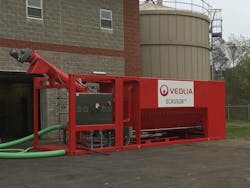Net Zero Resource Recovery
Introduction
Hermitage Municipal Authority is strategically located between Pittsburgh, Pa., and Cleveland, Ohio in northwestern Pennsylvania, providing wastewater services to the city of Hermitage and five neighboring communities. Hermitage also serves as a food waste disposal provider to the Great Lakes region and the only facility of its kind in Pennsylvania.
Hermitage Municipal Authority undertook a major upgrade of its solids handling facility. The facility had only secondary treatment, meaning there was no easy-to-digest, high caloric value primary sludge as a feed to the new anaerobic digesters. Goals of the solids handling facility upgrade were to increase treatment capacity and to boost biogas generation for use as the primary fuel in a combined heat and power (CHP) cogeneration system to offset process heat and generate renewable electricity. This led to a solids management plan specifically designed to address high-strength co-digestion of organic wastes imported to the facility and subsequent production of EPA approved Class A biosolids for biofertilizer and generation of renewable energy. As part of the upgrades, a hammermill depackaging unit was installed. This unit is labor intensive requiring frequent operator intervention.
The Solution
The design at the facility included a staging area to receive imported, packaged organic waste from grocers, large food manufacturers, the dairy industry and other waste generators. Veolia’s Ecrusor depackaging system for liquid and solid waste was implemented in parallel to the existing hammermill unit to extract organics from packaged imported waste. The Ecrusor system increased capacity by ten-fold, allowing reduction in labor and operation. The process is able to receive packaged material as is, which minimizes operator intervention. The method used by the Ecrusor for depackaging involves perforation of packaging, such as cardboard, cans, and plastic containers, while pressing organics from within the packaging to decrease the contamination of bio-slurry. Further screening of the organics insures zero contaminants enter downstream processes.
The Results
The phased digesters are fed a combination of secondary municipal sludge and depackaged organics, in some instances, with preheated, high-strength waste. The organics loading ratio on a mass basis for municipal sludge to imported waste ranges between 1-to-0.6 and 1-to-1, with 20 tons of municipal for every 12 to 20 tons of imported waste. The Ecrusor unit is capable of processing approximately 15 tons of imported organics per day that the facility accepts.
Summary
The project has been successfully implemented and provides the authority with a source of revenue and a location for the community to divert organics for beneficial reuse, successfully diverting these materials from local municipal landfills and increasing production of biogas.
Conversion of organics to renewable bioenergy within a wastewater facility is a cost-effective means of supporting solid waste utilities, while supplementing the portfolio requirements of the energy utilities. All of this while removing food wastes from our over-burdened landfills and putting into the energy grid at a savings to sewer rate payers.

